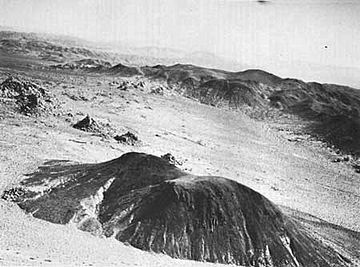Malapai Hill facts for kids
Quick facts for kids Malapai Hill |
|
|---|---|

Oblique aerial view of Malapai Hill, looking east
|
|
| Highest point | |
| Elevation | 4,278 feet (1,304 m) NGVD 29 |
| Prominence | 360 ft (110 m) |
| Geography | |
| Location | Riverside County, California, United States |
| Topo map | USGS Malapai Hill |
| Geology | |
| Mountain type | Volcanic plug |
Malapai Hill is a small mountain located in the middle of Joshua Tree National Park in southeastern California. It might have once been part of an ancient volcano. This hill was formed when hot, molten rock pushed its way up from deep inside the Earth. It either broke through the surface or was later uncovered as the softer rock around it wore away. The name "Malapai" comes from the Spanish word malpaís, which means "bad land."
Contents
Where is Malapai Hill?
This interesting hill stands tall within Joshua Tree National Park. It is found west of the Hexie Mountains and north of the San Bernardino Mountains. You can find it close to Queen Valley.
How Malapai Hill Formed
Malapai Hill was created when magma (molten rock) pushed into a type of granite rock called White Tank monzogranite. This magma then cooled down and became a hard, dark rock called basalt.
Scientists are not completely sure how the hill got its exact shape. It could have been part of an older volcano that erupted long ago. Or, the magma might have cooled underground without ever reaching the surface. Over millions of years, the softer granite around it wore away, leaving the harder basalt hill exposed.
Using a special method called argon dating, scientists have found that the basalt rock of Malapai Hill is about 15.93 million years old. That's a very long time!
What is Malapai Hill Made Of?
Malapai Hill has two main peaks, with the taller one to the north. Its steep sides are covered with piles of broken granite and basalt rocks.
The hill is mostly made of a dark, fine-grained rock called alkaline olivine basalt. This rock contains small crystals of olivine, which is a green mineral. You can also find pieces of other rocks inside it, called xenoliths. Many of these are lherzolite, which are bits of the Earth's mantle that were carried up by the magma. Sometimes, you can also find pieces of the White Tank monzogranite.
Earthquakes Near Malapai Hill
On February 26, 2015, a small earthquake with a strength of 3.7 happened right underneath Malapai Hill.
What Does "Malapai" Mean?
The name "Malapai" is an American way of saying the Spanish word malpaís. This word translates to "bad terrain" or "bad land." The term malpaís is often used to describe rugged, eroded areas made of volcanic rock. The area around Malapai Hill is a dry desert with cactus and desert shrubs, which fits the "bad terrain" description.
Exploring Malapai Hill
Even though there are no official trails, Malapai Hill is a popular spot for hikers. It is located in the Joshua Tree Wilderness area. The Angles Chapter of the Sierra Club even suggests it as a great place to visit.
Be careful if you use a compass near the top! There are rocks containing magnetite, which is a magnetic mineral. These rocks can make your compass act strangely and point in the wrong direction.


